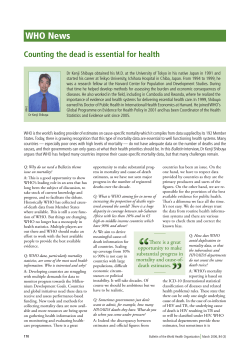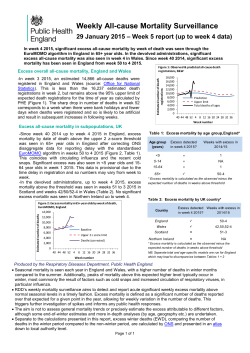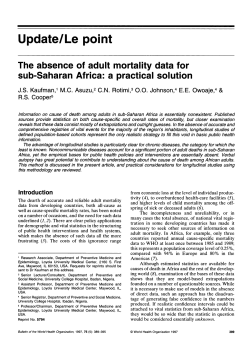
To the Point Benefit plan sponsors may need to making year-end assumptions
No. 2014-43 30 October 2014 To the Point Benefit plan sponsors may need to consider new mortality tables in making year-end assumptions Using the new mortality tables could increase a sponsor’s benefit obligation. What you need to know • The Society of Actuaries finalized new mortality tables and a new mortality improvement scale that could increase a sponsor’s benefit obligations and contributions. • The new mortality information reflects improved life expectancies and an expectation that the trend will continue. • Although sponsors are not required to use the tables or the improvement scale, they may need to consider the new mortality information when developing year-end mortality assumptions. • Sponsors will need to provide year-end MD&A disclosures about any significant changes in their benefit obligations resulting from use of the tables. Sponsors that haven’t issued interim financial statements for the latest period also should consider disclosures. • If the new mortality tables are used for calculating plan sponsors’ benefit costs and obligations, they should be consistently used for the plan’s financial statements as well. Overview The Society of Actuaries (SOA) 1 issued new mortality tables (RP-2014) and a mortality improvement scale (MP-2014) that could increase a sponsor’s obligations and contributions for defined benefit plans. Because the new tables and improvement scale reflect today’s longer life expectancies, plan sponsors may need to consider this new information (regardless of whether the plan is frozen) when measuring benefit costs and obligations that are based on the life expectancy of the EY AccountingLink | www.ey.com/us/accountinglink participants in their plans. The tables and scale are not significantly different from the draft versions the SOA proposed earlier this year. Sponsors that decide to use the new tables (or use them as a basis for their mortality rate assumptions) will need to determine which of the 11 tables or combination of tables are appropriate for their plans (the tables consider age, gender, income level and collar). Many sponsors that currently use the SOA’s older mortality tables and scales are expected to use the new tables and scale, unless they have “credible” information supporting the use of a different table and scale. Defined benefit plan sponsors are required to measure costs and obligations using their “best estimate” for the plan under Accounting Standards Codification (ASC) 715-30-35-42 and ASC 715-60-35-72. Such estimates should consider all available information as of the measurement date. Selecting appropriate assumptions is critical to measuring the components of a benefit plan and can significantly affect a sponsor’s financial statements. The mortality rate is a key assumption used in valuing many retirement plans because it reflects the probability of future benefit payments that are contingent upon plan participants’ life expectancies. Key considerations Plan sponsors will need to evaluate their mortality assumptions in light of longer life expectancies. While use of the SOA tables is not required, the SOA is a leading authority on actuarial research, and a large number of plan sponsors use its mortality tables and mortality improvement scale as a starting point or basis to develop their mortality assumptions. Sponsors that use other credible sources of mortality data may decide not to use the SOA’s tables. For example, this may be the case for very large plans that have sufficient historical data and mortality experience or demographics that are inconsistent with the SOA’s tables. Such circumstances may require a careful analysis by the sponsor, including consideration of changing trends in life expectancies. In addition to a base table, mortality rate assumptions typically include a mortality improvement scale that addresses anticipated rates of improvement in life expectancy and the period over which those rates apply. Based on historical data, a sponsor may be able to use base mortality rates that differ from the SOA’s tables to determine its best estimate. However, supporting customized improvement scales can be difficult. It is important to note that the RP-2014 mortality tables were not yet available when the Internal Revenue Service issued Notice 2013-32, which identifies the older mortality tables that will be in use for minimum funding purposes for a plan’s 2014 and 2015 plan years. If an entity uses the SOA tables as part of its estimation process, the new mortality tables should be considered and used consistently for estimating the plan sponsor’s benefit costs and obligations, and the obligations presented in the benefit plan’s financial statements that are measured subsequent to the issuance of the new mortality information. Sponsors that plan to use the new tables should evaluate the effect on their financial statements and consider disclosing at year end the reasons for any significant changes in benefit obligations and the general approach used to estimate mortality rates in management’s discussion and analysis (MD&A) under Item 303 of Regulation S-K and the retirement benefits footnote, respectively. Sponsors that haven’t yet issued their latest interim financial statements should consider MD&A disclosures if they anticipate significant changes in their benefit obligations resulting from use of the new tables. 2 | To the Point Benefit plan sponsors may need to consider new mortality tables in making year-end assumptions 30 October 2014 EY AccountingLink | www.ey.com/us/accountinglink Next steps • Plan sponsors should discuss the final tables with their actuaries and auditors now. Sponsors will need to evaluate the effect of the new information on their mortality rate assumptions, which should represent the best estimate for each plan. Any conclusions should be supported by well-documented, robust analysis and credible statistics. • The tables can be obtained on the SOA’s web site, www.soa.org. Endnotes: 1 EY | Assurance | Tax | Transactions | Advisory © 2014 Ernst & Young LLP. All Rights Reserved. SCORE No. BB2870 ey.com/us/accountinglink The SOA is a professional organization committed to the development of the actuarial profession, the enhancement of actuarial-related research and the high standards of competency to which its members are held. About EY EY is a global leader in assurance, tax, transaction and advisory services. The insights and quality services we deliver help build trust and confidence in the capital markets and in economies the world over. We develop outstanding leaders who team to deliver on our promises to all of our stakeholders. In so doing, we play a critical role in building a better working world for our people, for our clients and for our communities. EY refers to the global organization, and may refer to one or more, of the member firms of Ernst & Young Global Limited, each of which is a separate legal entity. Ernst & Young Global Limited, a UK company limited by guarantee, does not provide services to clients. For more information about our organization, please visit ey.com. Ernst & Young LLP is a client-serving member firm of Ernst & Young Global Limited operating in the US. This material has been prepared for general informational purposes only and is not intended to be relied upon as accounting, tax, or other professional advice. Please refer to your advisors for specific advice. 3 | To the Point Benefit plan sponsors may need to consider new mortality tables in making year-end assumptions 30 October 2014
© Copyright 2025

















